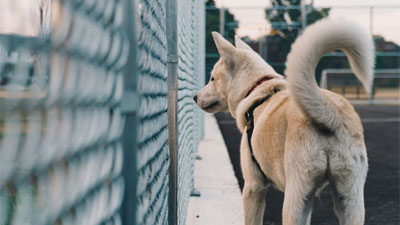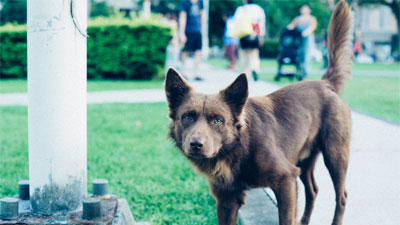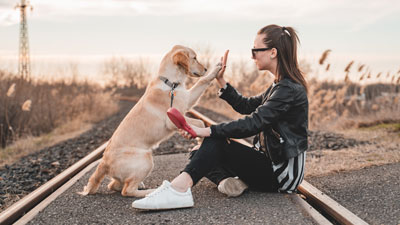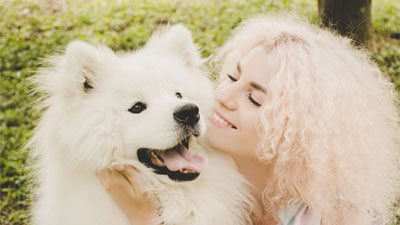- Size
- Smallest
- Small
- Small to Medium
- Medium
- Large
- Giant
- Characteristics
- Smartest
- Hypoallergenic
- Fluffy
- Best Guard
- Best Family
- Best for Kids
- Low Shedding
- Healthiest
- Police Dogs
- Most Calm
- Quietest
- Color
- White
- Black
- Grey
- Brown
- Blue
- Red
- Coat
- Hairless
- Short
- Long
- Origin
- Japan
- China
- Australia
- Germany
- Italy
- United States
- France
- Group
- Hound
- Terrier
- Herding
- Toy
- Working
- Sporting
What Does It Mean When A Dog's Hackles Stand Up?

Photo by Wang Sheeran on Unsplash
Dogs are extraordinary communicators, expressing their emotions and intentions through a rich tapestry of body language. Among the intriguing signals that dogs use to convey their state of mind, raised hackles stand out as a visible and often misunderstood phenomenon. In this exploration, we'll delve into the fascinating world of dog hackles, seeking to unravel the complexities behind why a dog's hackles are raised and what these raised hairs signify.
What are Hackles in Dogs?
Before we delve into the meanings behind raised hackles, it's important to understand what hackles are. These are simply the prickly hairs on a dog's neck, back, and tail, controlled by tiny muscles known as arrector pili. Under certain circumstances, such as when dogs feel threatened, their muscles contract, causing the hair to stand on end.
What Does it Mean When a Dog's Hackles Are Raised?
Raised hackles are a clear indication that a dog is experiencing some emotional response. Contrary to popular belief, raised hackles alone do not automatically spell danger or aggressive behavior. Instead, they are a visible communication tool through which a dog reveals their emotional state.
Here are a few common reasons why a dog's hackles may become raised:
1. Excitement or High Arousal
A common reason why dog's hackles are raised is when they are experiencing high arousal or excitement, such as when they are playing or doing something stimulating. Typically, the raised hackles are accompanied by other signs of excitement, such as general playfulness and a wagging tail.
2. Fear and anxiety
Hackles can also be raised as a result of fear or anxiety. When a dog feels uncomfortable or threatened, they may raise their hackles as a response. This can make the dog appear larger and more intimidating, which could deter potential predators or threats. Additional behaviors such as crouching, trembling, aversion, or defensive posturing may accompany the raised hackles.
Related: Helping Your Dog with Desensitization and Counterconditioning
3. Aggression or agitation
Raised hackles can also be a sign of aggression or agitation in certain situations. If a dog feels challenged, provoked, or threatened, their hackles can rise in defense readiness. Other behaviors associated with aggression in dogs may include bared teeth, snarling, stiff body posture, and direct eye contact.
4. Overstimulation or Frustration
Hackles can shoot up due to overstimulation or frustration. Sometimes, if a dog is exposed to intense or excessive stimuli, their nervous system can become overwhelmed. In these cases, raised hackles are a response to the sensory overload and can be accompanied by other signs of stress, such as pacing, panting, restlessness, or a desire to escape from the situation.
5. Social communication
Raised hackles can also represent a form of social communication among dogs. When two dogs interact, raised hackles can be used to convey assertiveness, readiness to play, or even caution. In these situations, it's important to consider the combination of body language cues along with the raised hackles to derive the right meaning.
Interpreting Raised Hackles: What Else to Look For
While the appearance of raised hackles can offer valuable insights into a dog's emotional state, it's important to interpret them in context, taking into account other body language cues. The following are some additional factors to consider when interpreting raised hackles:
Overall body posture: The general posture of the dog can help a dog owner understand what a raised hackle means. If the dog is nervous or tense, it can indicate fear or anxiety. If the dog is relaxed or exhibiting playful behaviors, the hackles raised might be a result of happiness.
Tail position and wagging: By paying attention to the dog's tail, dog owners can read the animal's emotional state. A relaxed, wagging tail generally indicates a friendly or positive state, while a low-held tail can signal fear or unease. When interpreting raised hackles, the position of the tail and whether it's wagging or held low is also crucial.
Ear position: Observe the position of the dog's ears. Forward-facing ears usually indicate attentiveness, while flattened or pulled-back ears could signal fear, submission, or aggression. In combination with raised hackles, the ear position can provide more understanding of the dog's emotional state.
Facial expressions: Dogs use facial expressions to communicate their emotions. Observe the dog's eyes, mouth, and overall facial tension. Dilated pupils, fixed stares, or bared teeth may indicate fear or aggression. Relaxed eyes and an open mouth convey a more relaxed and friendly state.
Vocalizations: The dog's vocalizations, such as growling, barking, or whining, can be valuable cues. Raised hackles combined with aggressive vocalizations require immediate attention and professional assistance. If the hackles are accompanied by playful vocalizations or high-pitched barks, it may indicate excitement or anticipation.
Context and environment: Understanding the wider context and environment in which the raised hackles occur can also help provide an explanation. Dogs may display raised hackles in unfamiliar situations or during encounters with other animals or specific triggers. The context can help determine the appropriate action plan.
Distinctive Hackle Displays Across Dog Breeds
The visibility of raised hackles can vary among different dog breeds. Breeds with shorter and finer coats, such as German Shepherds, Doberman Pinschers, and Boxers, tend to exhibit raised hackles more prominently. This is because their sleek coats allow the raised hairs to be more easily seen. On the other hand, breeds with longer or thicker coats, like Golden Retrievers, Poodles, or Shih Tzus, may not display raised hackles as visibly due to their thicker fur.
It's important to take these breed-specific variances into account when interpreting the communication conveyed through raised hackles. While some breeds may naturally have more visible hackles, the emotional meaning behind the behavior remains the same. It's still crucial to consider other body language cues and the overall context to fully understand a dog's emotional state.
Conclusion
Raised hackles in dogs can indicate a range of emotions, not just aggression. While it is commonly associated with heightened arousal or feeling threatened, it can also signify excitement, fear, or even playfulness. It is important to observe other body language cues such as the position of the ears, tail, and overall body posture to get a comprehensive understanding of a dog's emotional state. Additionally, considering the context in which the hackles are raised can provide valuable insight into why the dog is displaying such behavior.
You May Also Like
 Dog BehaviorWhat Do The Different Dog Tail Positions Mean?
Dog BehaviorWhat Do The Different Dog Tail Positions Mean? Dog BehaviorHow Do Dogs Show Their Emotions?
Dog BehaviorHow Do Dogs Show Their Emotions? Dog BehaviorThe 6 Common Dog Sounds and Their Meanings
Dog BehaviorThe 6 Common Dog Sounds and Their Meanings Help & AdviceWhat Is The Hardest Dog Trick?
Help & AdviceWhat Is The Hardest Dog Trick? Dog Training TipsHere are the 7 Most Important Dog Commands
Dog Training TipsHere are the 7 Most Important Dog Commands Dog Training Tips5 Easy Steps: How to Teach a Dog to Smile
Dog Training Tips5 Easy Steps: How to Teach a Dog to Smile